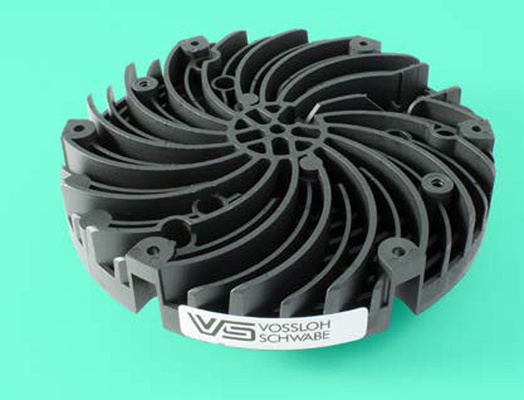Lati Industria Termoplastici SpA - Sucursal en España - Sockets, heat sinks and other accesories
Disipadores For LED: thermoplastic vs aluminium

Light, efficient, of low environingingmental impact; like this it can present the disipador for the system of lighting LED that Vossloh Schwabe has designed using a material of Lati developed especially for the application: Laticonther 62 GR/50.
In base PA 6, this degree térmicamente conductivo allows an effective cooling of the electronics equipment dealers equipment dealers of the LED thanks to a particular graphite entered in the compound in corresponding quantity to 50% of the weight and endowed of a structure that allows preferential ways of transfer of heat.
The election of the resin of base has done jointly with Vossloh Schwabe considering like main aim the ease of filled of the cavities of the mould operating in conditions no extreme.
Once tuned the process of injection also adjusted the geometry of the piece to guarantee the maximum dimensional stability necessary for a safe setting of the element radiator on the electronics equipment dealers equipment dealers and the lens of the LED.
The result of the collaboration between Vossloh Schwabe and Lati is a family of disipadores of several forms, measures and applications.
In fact, the disipadores in plastic termoconductor use in modular projects realizar to substitute conventional lamps of halógenos or fluorescent for public use, corporate, commercial or domestic.
The form and the efficiency of the radiant system calibrate in function of the numbers of LEDS into use and of the power of each one (until 700 mA each one)
In the catalogue of Vossloh Schwabe can find so many lamps spot like solutions designed to operate directly in tension of network of 230 V.
The use of resins termoconductoras of injection allows besides obtain complex forms and dimensional precision resulting more efficient the process of assembling of the final product.
The product selected is between the ones of more provision of the family Laticonther, with a thermal sensors conductivity of some 10 W/mK, of course lower that the one of the aluminium, but sufficient for solutions especially configured
The conditions of transformation need temperatures of fusion of the very inferior polymer to the ones of the metal, greater length of the moulds and practically any processed after the injection, factors that do that this was an interesting solution so much from the technical point of view as from the economic and of marketing.
The catalogues and technical support of Lati and Vossloh Schwabe can obtain of his portals of internet.
In base PA 6, this degree térmicamente conductivo allows an effective cooling of the electronics equipment dealers equipment dealers of the LED thanks to a particular graphite entered in the compound in corresponding quantity to 50% of the weight and endowed of a structure that allows preferential ways of transfer of heat.
The election of the resin of base has done jointly with Vossloh Schwabe considering like main aim the ease of filled of the cavities of the mould operating in conditions no extreme.
Once tuned the process of injection also adjusted the geometry of the piece to guarantee the maximum dimensional stability necessary for a safe setting of the element radiator on the electronics equipment dealers equipment dealers and the lens of the LED.
The result of the collaboration between Vossloh Schwabe and Lati is a family of disipadores of several forms, measures and applications.
In fact, the disipadores in plastic termoconductor use in modular projects realizar to substitute conventional lamps of halógenos or fluorescent for public use, corporate, commercial or domestic.
The form and the efficiency of the radiant system calibrate in function of the numbers of LEDS into use and of the power of each one (until 700 mA each one)
In the catalogue of Vossloh Schwabe can find so many lamps spot like solutions designed to operate directly in tension of network of 230 V.
The use of resins termoconductoras of injection allows besides obtain complex forms and dimensional precision resulting more efficient the process of assembling of the final product.
The product selected is between the ones of more provision of the family Laticonther, with a thermal sensors conductivity of some 10 W/mK, of course lower that the one of the aluminium, but sufficient for solutions especially configured
The conditions of transformation need temperatures of fusion of the very inferior polymer to the ones of the metal, greater length of the moulds and practically any processed after the injection, factors that do that this was an interesting solution so much from the technical point of view as from the economic and of marketing.
The catalogues and technical support of Lati and Vossloh Schwabe can obtain of his portals of internet.


